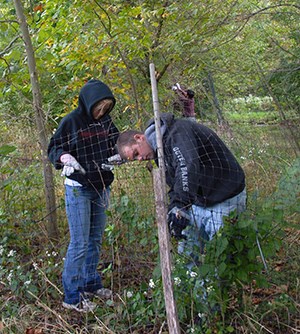
NPS Photo. The War on WeedsAs suburban sprawl spreads around Valley Forge National Historical Park, the park becomes increasingly important as a refuge for native plants and animals. The habitats in the park, including oak and poplar forests, meadows, wetlands, water, and forested floodplains, support over 1,000 different kinds of plants and 300 animal species. Non-Native PlantsApproximately 1/3 of the plants in the park are non-native. A non-native plant is a species that has been introduced with human help, either intentionally or by accident, and was not previously found in the area. Not all non-native plants are invasive. In fact, when some non-native plants are introduced to new places, they cannot reproduce or spread readily without continued human help (for example, many ornamental plants). Non-Native, Invasive PlantsThirty of the around 300 non-native plants found at Valley Forge are also considered invasive or "weedy" species that can cause significant environmental or economic harm, and/or pose a threat to human health. Non-native, invasive plants are our target in the "war on weeds." 
NPS Photo. Why We FightThe spread of non-native, invasive species is one of the leading causes of ecosystem degradation and loss of biodiversity worldwide. These plants can tolerate a wide range of environmental conditions, such as temperature, shade, and moisture and they often possess traits that allow them to spread rapidly, such as prolific seed production and rapid growth rate. Additionally, the predators, parasites, and diseases that keep these species in check in their native lands are not present here. Biological PollutionThe negative impacts that non-native, invasive plants have on native plants and animals is called biological pollution or biopollution. At Valley Forge invasive plants are considered a direct threat to natural resources because they:
It is estimated that non-native, invasive plants spread into an area roughly the size of Delaware each year. At Valley Forge, all habitats are experiencing some level of degradation and loss of diversity due to the spread of these aggressive invaders. What Can I Do?You can volunteer as a park Weed Warrior and participate year-round in activities to remove various species of non-native, invasive plants. 'Weed' removal is accomplished using mechanical methods, including hand pulling and cut and cover, and may also involve the use of hand tools. These are great opportunities for both groups and individuals. Participants should come prepared to get down and dirty! All ages are welcome and park staff will provide necessary training and equipment, including gloves and eye protection. Participants should wear long pants, a long sleeve shirt and closed toed shoes such as hiking boots. Receive a Weed Warriors button the first time you participate, and earn a Weed Warriors t-shirt after you participate three times! 
NPS Photo/ C. Wusteney Frequently Asked Questions1. What will I do?Weed Warriors volunteers take part in a variety of activities including hand pulling and cutting invasive species, installing and maintaining tree cages, spreading native seed, planting trees, and other activities, depending on the season. Activities often include using hand tools such as loppers, hand saws and clippers, as well as bending and moving vegetation. Work takes place among vegetation and on uneven surfaces. There may be a short hike to the work location. Volunteers are encouraged to work at their own pace and comfort level and to take breaks as needed. You will receive an email from Park staff about a week before your scheduled event, which will include the planned tasks for the event. At the event, staff will teach all skills needed to complete the project, including tool safety, plant identification, etc. Please reach out to park staff if you would like more information or would like to discuss whether Weed Warriors is a good fit for you. 2. What should I wear?Volunteers are required to wear long pants, a long-sleeved shirt, and closed toed shoes. Volunteers should dress for the weather and wear comfortable clothes for working among vegetation and walking on uneven terrain. Eye protection and work gloves are required and are provided at the volunteer event, though you may bring your own if you prefer. 3. What should I bring?Bring a good attitude, water, and snacks! Activities may take place a short hike from the parking area, so you may want to bring a bag to carry things with you. The park provides all tools and personal protective equipment, and has bug spray, sunblock, and a handwashing station available for volunteer use. 4. Can children come to weed warriors?Children are welcome at Weed Warriors events and must be accompanied by an adult. Please use your judgement in determining whether this will be an enjoyable and suitable activity for your child. 5. What does my work with Weed Warriors help accomplish?By removing invasive plant species, you help open the landscape for the return of native plants, which helps to protect biodiversity and provide resilient habitat for plants and animals. Your efforts as a Weed Warrior go hand in hand with other management efforts to maintain the Park’s ecosystems. 6.When and where does Weed Warriors meet?Weed Warriors volunteer events take place Fall through Spring; join our email list to get specific dates. Events are three hours long, typically in the morning, and meet throughout Valley Forge depending on the work to be completed. Volunteer opportunities are available on weekdays and Saturdays. About a week before your scheduled event, you will receive an email from Park Staff. This email will have information about the specific meeting location, planned tasks, as well as a phone number to contact staff on the day of the event. 
NPS Photo. How to JoinTo join the Weed Warriors visit volunteer.gov, or email our Natural Resources staff. |
Last updated: December 17, 2024
